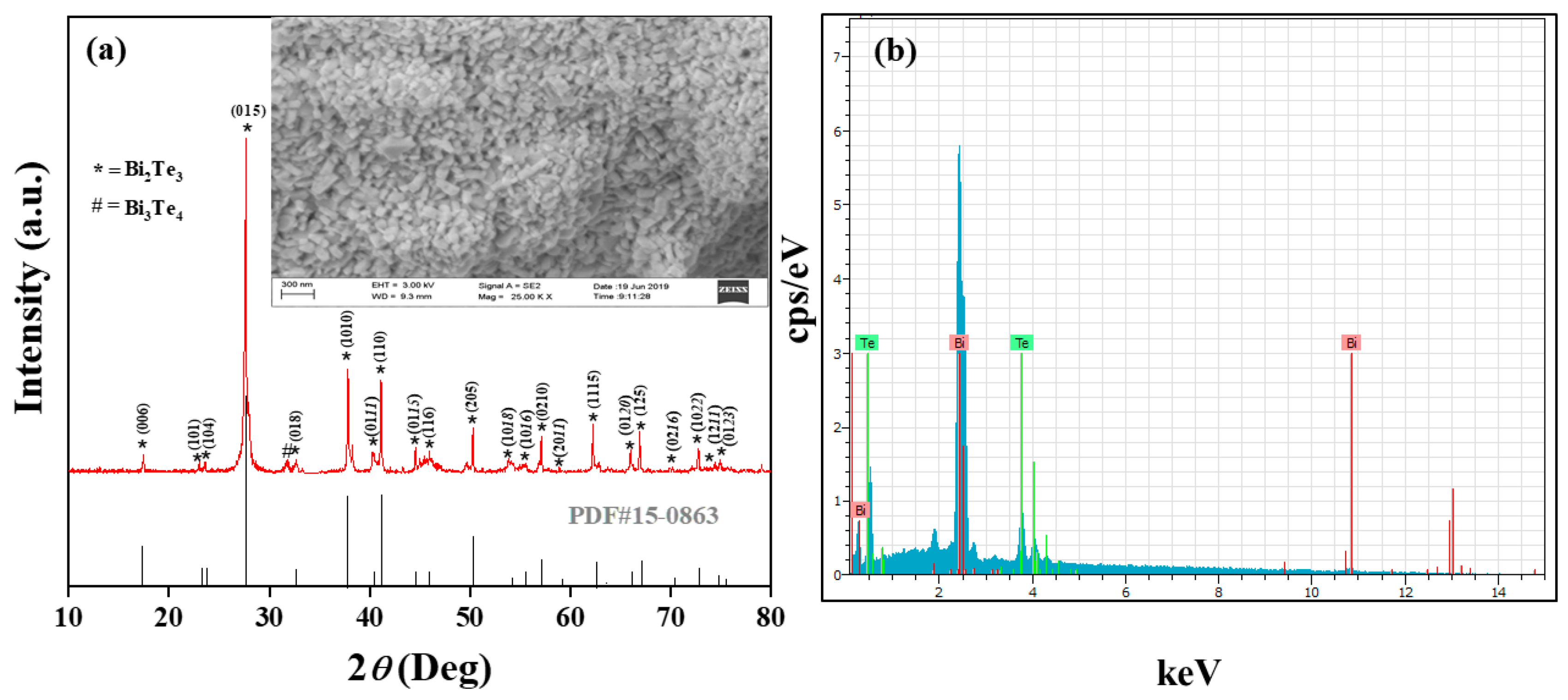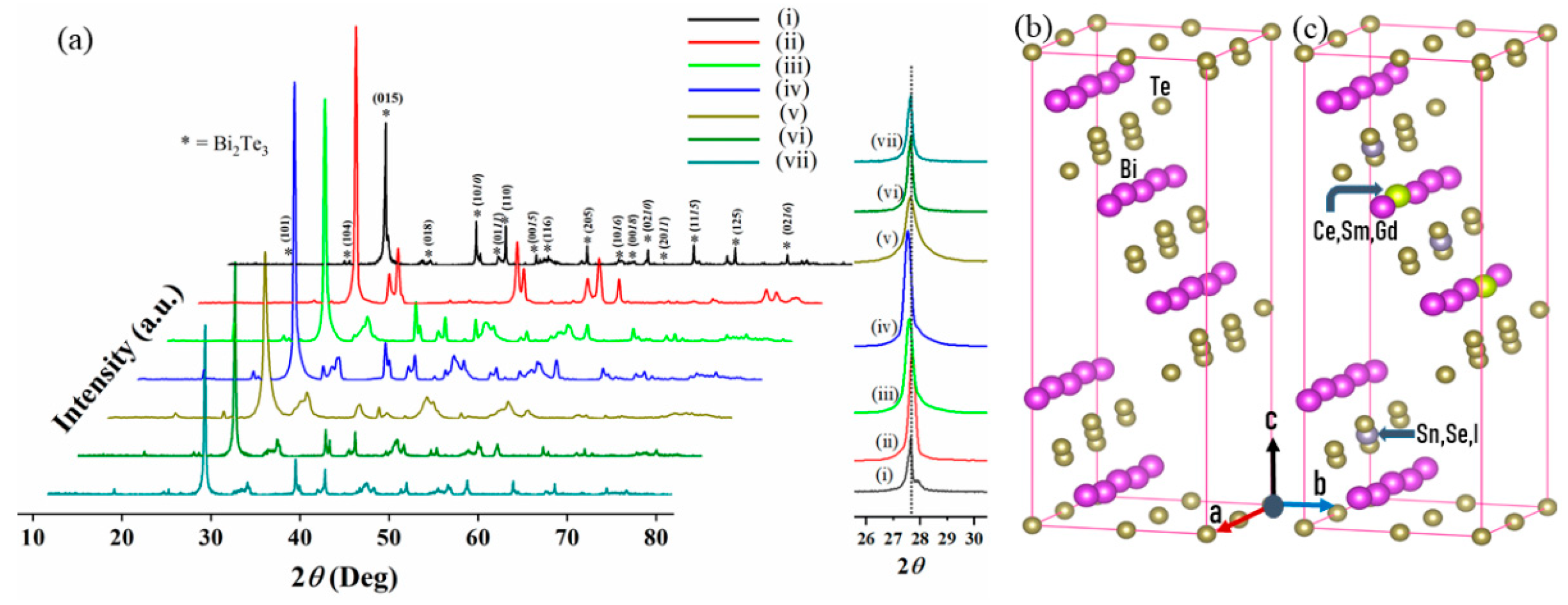Effect of Co-Doping on Thermoelectric Properties of n-Type Bi2Te3 Nanostructures Fabricated Using a Low-Temperature Sol-Gel Method
Abstract
:1. Introduction
2. Materials and Methods
Fabrication of Co-Doped Nanostructures of Bi2Te3
Characterization Techniques
3. Results
Phase Purity, Morphology, and Thermal Properties of Pure Bi2Te3
Phase Composition, Crystallinity, and Thermal Properties of Co-Doped Bi2Te3
4. Conclusions
Author Contributions
Funding
Institutional Review Board Statement
Informed Consent Statement
Data Availability Statement
Acknowledgments
Conflicts of Interest
References
- Bhattacharya, M.; Paramati, S.R.; Ozturk, I.; Bhattacharya, S. The effect of renewable energy consumption on economic growth: Evidence from top 38 countries. Appl. Energy 2016, 162, 733–741. [Google Scholar] [CrossRef]
- Venkatasubramanian, R.; Siivola, E.; Colpitts, T.; O’Quinn, B. Thin-film thermoelectric devices with high room-temperature figures of merit. Nature 2001, 413, 597–602. [Google Scholar] [CrossRef] [PubMed]
- Han, C.; Li, Z.; Dou, S.X. Recent progress in thermoelectric materials. Chin. Sci. Bull. 2014, 5, 2073–2091. [Google Scholar] [CrossRef] [Green Version]
- Tritt, T.M. Holey and unholey semiconductor. Science 1999, 83, 804–805. [Google Scholar] [CrossRef]
- Sales, B.C. Thermoelectric materials. Smaller is cooler. Science 2002, 295, 1248–1257. [Google Scholar] [CrossRef] [PubMed]
- Hicks, L.D.; Dresselhaus, M.S. Effect of quantum-well structures on the thermoelectric figure of merit. Phys. Rev. B 1993, 47, 12727–12731. [Google Scholar] [CrossRef]
- Snyder, G.J.; Toberer, E.S. Complex thermoelectric materials. Nat. Mater. 2008, 7, 105–114. [Google Scholar] [CrossRef]
- Vineis, C.J.; Shakouri, A.; Majumdar, A.; Kanatzidis, M.G. Nanostructured thermoelectrics: Big efficiency gains from small features. Adv. Mater. 2010, 22, 3970–3980. [Google Scholar] [CrossRef]
- Lan, Y.C.; Minnich, A.J.; Chen, G.; Ren, Z.F. Enhancement of thermoelectric figure-of-merit by a bulk nanostructuring approach. Adv. Funct. Mater. 2010, 2, 357–376. [Google Scholar] [CrossRef]
- Li, J.F.; Liu, W.S.; Zhao, L.D.; Zhou, M. High-performance nanostructured thermoelectric materials. NPG Asia Mater. 2010, 2, 152–158. [Google Scholar] [CrossRef]
- Liu, W.S.; Yan, X.; Chen, G.; Ren, Z.F. Recent advances in thermoelectric nanocomposites. Nano Energy 2012, 1, 42–46. [Google Scholar] [CrossRef]
- Alam, H.; Ramakrishna, S. A review on the enhancement of figure of merit from bulk to nano-thermoelectric materials. Nano Energy 2013, 2, 190–212. [Google Scholar] [CrossRef]
- Poudel, B.; Hao, Q.; Ma, Y.; Lan, Y.; Minnich, A.; Yu, B.; Yan, X.; Wang, D.; Muto, A.; Vashaee, D.; et al. High-thermoelectric performance of nanostructured bismuth antimony telluride bulk alloys. Science 2008, 320, 634–642. [Google Scholar] [CrossRef] [PubMed] [Green Version]
- Xie, W.J.; He, J.; Kang, H.J.; Tang, X.F.; Zhu, S.; Laver, M.; Wang, S.Y.; Copley, J.R.D.; Brown, C.M.; Zhang, Q.J.; et al. Identifying the specific nanostructures responsible for the high thermoelectric performance of (Bi, Sb)2Te3 nanocomposites. Nano Lett. 2010, 10, 3283–3289. [Google Scholar] [CrossRef] [PubMed]
- Lu, W.; Ding, Y.; Chen, Y.; Wang, Z.L.; Fang, J. Bismuth telluride hexagonal nanoplates and their two-step epitaxial growth. J. Am. Chem. Soc. 2005, 127, 10112–10116. [Google Scholar] [CrossRef]
- Deng, Y.; Cui, C.W.; Zhang, N.L.; Ji, T.H.; Yang, Q.L.; Guo, L. Fabrication of bismuth telluride nanotubes via a simple solvothermal process. Solid State Commun. 2006, 138, 111–113. [Google Scholar] [CrossRef]
- Zhang, Z.; Sharma, P.A.; Lavernia, E.J.; Yang, N. Thermoelectric and transport properties of nanostructured Bi2Te3 by spark plasma sintering. J. Mater. Res. 2011, 26, 475–484. [Google Scholar] [CrossRef]
- Tang, X.; Xie, W.; Li, H.; Zhao, W.; Zhang, Q.; Niino, M. Preparation and thermoelectric transport properties of high-performance p-type Bi2Te3 with the layered nanostructure. Appl. Phys. Lett. 2007, 90, 12102–12103. [Google Scholar] [CrossRef]
- Cao, Y.; Zhao, X.; Zhu, T.; Zhang, X.; Tu, J. Syntheses and thermoelectric properties of Bi2Te3/Sb2Te3 bulk nanocomposites with the laminated nanostructure. Appl. Phys. Lett. 2008, 92, 143106. [Google Scholar] [CrossRef]
- Golia, S.; Arora, M.; Sharma, R.; Rastogi, A. Electrochemically deposited bismuth telluride thin films. Curr. Appl. Phys. 2003, 3, 195–197. [Google Scholar] [CrossRef]
- Li, Z.; Teng, R.; Zheng, S.; Zhang, Y.; Huang, T.; Lu, G. Single-crystalline Bi2Te3 nanosheets with uniform morphology via a simple, efficient, and high-yield microwave-assisted synthesis. J. Cryst. Growth 2014, 406, 104–110. [Google Scholar] [CrossRef]
- Son, J.S.; Choi, M.K.; Han, M.K.; Park, K.; Kim, J.Y.; Lim, S.J. n-type nanostructured thermoelectric materials prepared from chemically synthesized ultrathin Bi2Te3 nanoplates. Nano Lett. 2012, 12, 640–647. [Google Scholar] [CrossRef] [PubMed]
- Galkina, O.; Vinogradov, V.; Agafonov, A.; Vinogradov, A. Surfactant-assisted sol-gel synthesis of TiO2 with uniform particle size distribution. Int. J. Inorg. Chem. 2012, 2011, 108087–108088. [Google Scholar] [CrossRef] [Green Version]
- Kumar, A.; Malik, A.K.; Tewary, D.K.; Singh, B. A review on the development of solid-phase microextraction fibers by sol-gel methods and their applications. Anal. Chim. Acta 2008, 610, 1–14. [Google Scholar] [CrossRef]
- Sanchez, C.; Ribot, F.; Doeuff, S. Transition metal oxo polymers synthesized via sol-gel chemistry. In Inorganic and Organometallic Polymers with Special Properties; Laine, R.M., Ed.; Springer: Dordrecht, The Netherlands, 1992; Volume 206, pp. 267–295. [Google Scholar]
- Qihao, Z.; Xin, A.; Lianjun, W.; Yanxia, C.; Wei, L.; Wan, J.; Lidong, C. Improved thermoelectric performance of silver nanoparticles-dispersed Bi2Te3 composites deriving from hierarchical two-phased heterostructure. Adv. Funct. Mater. 2015, 25, 966–976. [Google Scholar]
- He, M.; Ge, J.; Lin, Z.Q.; Feng, X.H.; Wang, X.W.; Lu, H.B.; Yang, Y.L.; Qiu, F. Thermopower enhancement in conducting polymer nanocomposites via carrier energy scattering at the organic-inorganic semiconductor interface. Energy Environ. Sci. 2012, 5, 8351–8358. [Google Scholar] [CrossRef]





Publisher’s Note: MDPI stays neutral with regard to jurisdictional claims in published maps and institutional affiliations. |
© 2021 by the authors. Licensee MDPI, Basel, Switzerland. This article is an open access article distributed under the terms and conditions of the Creative Commons Attribution (CC BY) license (https://creativecommons.org/licenses/by/4.0/).
Share and Cite
Irfan, S.; Din, M.A.U.; Manzoor, M.Q.; Chen, D. Effect of Co-Doping on Thermoelectric Properties of n-Type Bi2Te3 Nanostructures Fabricated Using a Low-Temperature Sol-Gel Method. Nanomaterials 2021, 11, 2719. https://doi.org/10.3390/nano11102719
Irfan S, Din MAU, Manzoor MQ, Chen D. Effect of Co-Doping on Thermoelectric Properties of n-Type Bi2Te3 Nanostructures Fabricated Using a Low-Temperature Sol-Gel Method. Nanomaterials. 2021; 11(10):2719. https://doi.org/10.3390/nano11102719
Chicago/Turabian StyleIrfan, Syed, Muhammad Aizaz Ud Din, Muhammad Qaisar Manzoor, and Deliang Chen. 2021. "Effect of Co-Doping on Thermoelectric Properties of n-Type Bi2Te3 Nanostructures Fabricated Using a Low-Temperature Sol-Gel Method" Nanomaterials 11, no. 10: 2719. https://doi.org/10.3390/nano11102719




